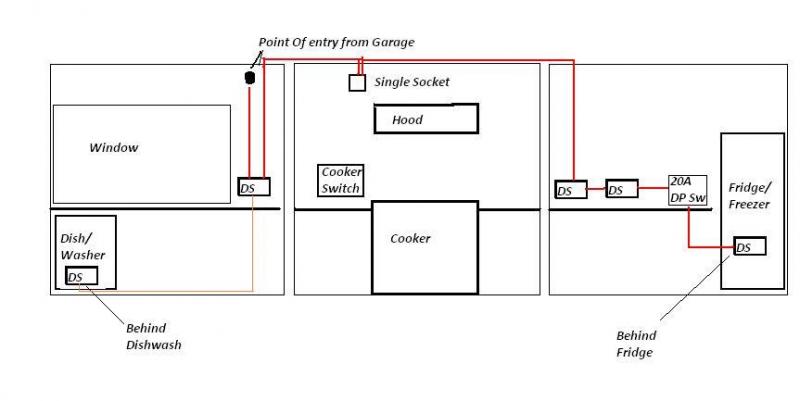Being relatively new, the biggest problem I have is lack of experience when it comes to deciding the easiest/quickest/cheapest/best way of doing an installation. I have been asked to install a new power circuit in a new kitchen extension. In the diagram below you can see the left wall, the facing wall and the right wall as you face it from the open plan entrance. There is a cu with a spare (RCD protected) way in the garage just behind the left hand wall. I was going to install a radial circuit protected by a 20a MCB.
The route I was intending to take is shown in red. The ceiling hasn't been plasterboarded yet so access via the ceiling void is easy. As a matter of interest how would anyone else so this?
Also, for the dishwasher, I was going to come down from the socket by the window and along the back of the units (in trunking). However, because of the window I cannot put an isolator above the appliance. Would it be ok for me to put an isolator to the right of the window (its about 2 metres away)?
Finally, it seems that some people suggest using a 20a DP switch as a means of isolating a socket whereas others say use a Switch Fused Spur. Is this just personal preference?
The route I was intending to take is shown in red. The ceiling hasn't been plasterboarded yet so access via the ceiling void is easy. As a matter of interest how would anyone else so this?
Also, for the dishwasher, I was going to come down from the socket by the window and along the back of the units (in trunking). However, because of the window I cannot put an isolator above the appliance. Would it be ok for me to put an isolator to the right of the window (its about 2 metres away)?
Finally, it seems that some people suggest using a 20a DP switch as a means of isolating a socket whereas others say use a Switch Fused Spur. Is this just personal preference?



